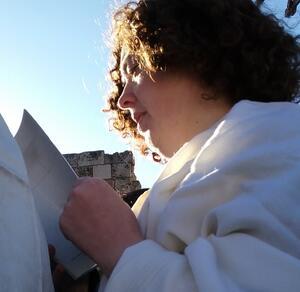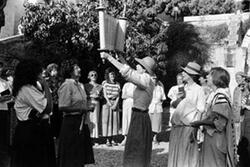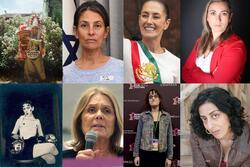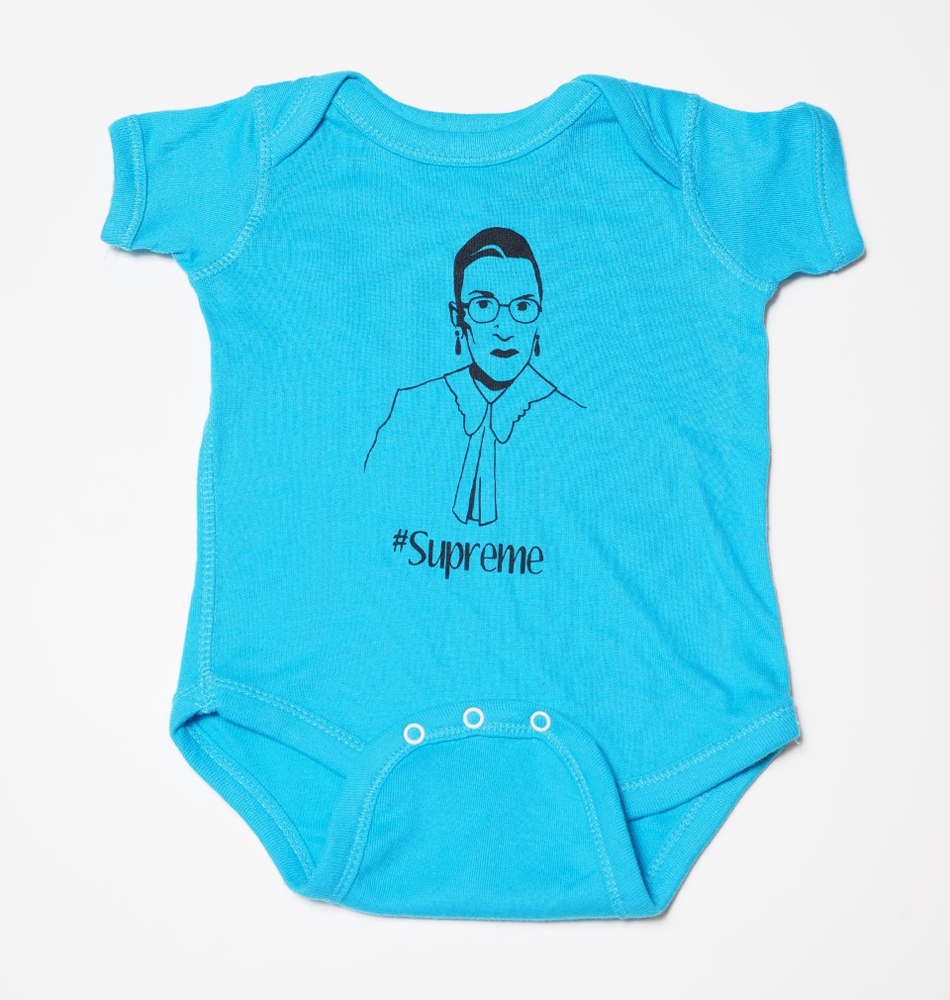Celebrating the New Moon in Jerusalem
My connection to Women of the Wall (WOW) began in August 1989 when I arrived in Israel with my husband and two young children, embarking on the adventure of a year-long sabbatical. Aside from the drumbeat of mothering which anchored my days, I studied with an Israeli ceramicist, took a year-long workshop in theatre and midrash, worked on a new play, wrote many poems, and joined my dear friend and Israeli peace activist Veronika Cohen to participate in numerous ongoing Israeli-Palestinian dialogue groups, ultimately organizing and co-leading such a group for women in the West Bank town of Beit Sahour. And once a month that year, to celebrate Rosh Hodesh, I would wake up early to daven with the newly formed Women of the Wall, a group of Israelis with a smattering of “internationals” like me who were advocating for equal access for women to pray at the Kotel.
We were often faced with violence that year—shoving, physical and verbal threats, chair-throwing. We were attacked by Ultra-Orthodox women and men who were offended by our audacity to claim our equal right to a sacred space. I recall my careful preparations: tying up and covering my very long hair and removing my dangling earrings so as not to provide easy targets for pulling and injury. One way or another, opportunities for courage abounded that year, whether traversing the West Bank or davening in a minyan of women at the Kotel.
Fast forward nearly 30 years. It’s January 2019, my daughter Lisa is thriving in her first year of rabbinical school, enrolled at the Conservative Yeshiva in Jerusalem, davening each month with WOW. Visiting for two weeks, I am delighted to be going together. We set the alarm early, get done in the dark, arrive at the Kotel, and join a large throng of women already immersed in their morning prayers. I’ve celebrated Rosh Hodesh here countless times since 1989; this time it’s winter, and the temperature is in the 30s. It’s a windy day, but the bright sun is slowly coming up over the horizon. We stand close together—to better hear one another as Haredi men and women try to drown out our voices, but also to share a bit of extra warmth, to lend support to one another. We enjoy a lusty singing of Hallel (special psalms included in the Rosh Hodesh service). I feel peaceful, at ease. I remember myself here as a much younger woman. I gaze at the enormous stones of the retaining wall and experience as always the miracle that I am participating in a minyan of women at this holy site.
I touch the corner of my tallit where I have sewn a small piece of lace I purchased in Zilina, the Slovakian town where my great-great-grandparents and great-grandparents made their home, where several of their children and a grandchild perished in 1942. I breathe in the Jerusalem air for them, relish the cold on my cheeks, look up at the stones and the grasses growing between, tell them I am here with my daughter; after intervening generations of assimilation, she is studying here this year as her father did more than 50 years ago, embarking on a path to become a rabbi. Miracle upon miracle.
Anat Hoffman, director of WOW, informs us it was not possible today to smuggle in a Torah scroll, instead we read the morning’s Torah from a small parchment. Then, we say a prayer for those who need healing and I focus on an index card on which I’ve written many names, conjure each face. At the end of the long list, I remember to include myself, shaking my head that my wellbeing remains an afterthought to me, despite some health problems these past months that almost prevented me from making this trip, compounded with my now ever-present companion, arthritis, which randomly wreaks havoc with knees and ankles, making walking difficult, painful, and necessitates that I carry a bulky cane for assistance.
Our prayers completed, I am looking forward to lingering, saying hello to old-timers, to moving all the way to the Wall itself and touching the cold stones. But Anat announces we need to leave in unison, for safety’s sake. So we turn about, link arms, on my left Lisa, on my right, her friend, a younger fellow student. We are singing, Ozi v’zimrat Yah, Vay yehi, lishua, a song I cherish, a song I first learned from David Bauer, a beloved Reconstructionist rabbi friend, a song I used to lead my students in singing when I held sessions in spiritual writing at Yeshivat Chovevei Torah, an Orthodox rabbinical school in New York. God is my strength and my delight, God is my deliverance.
We, the Women of the Wall, are encircled by a phalanx of IDF soldiers, also with linked arms, because just outside their circle is a third circle, three rows deep, of men and boys in black, with peyes, who are pressing in, shouting at us, menacing. Perhaps surprisingly, I don’t have trouble blocking out the sounds of the hostile voices, whatever they are shouting. Only once or twice do I look at their faces distorted in anger. Ozi v’zimrat Yah. I feel through my winter coat and through her winter coat the arm of the young woman on my right—just recently out of college. She is shaking. I can feel the tremors through the layers of our winter coats. Is it the cold, or the menacing bodies pressing in on us? I try through my coat and her coat to communicate strength, calm, safety. Ozi v’zimrat Yah. We women are being pushed closer and closer together by the third concentric circle, the men and boys in black. Slowly we approach the exit, three concentric circles of several hundred people. Most of the daveners are ushered onto the waiting buses which brought them.
But Lisa and I are meeting a friend for breakfast in Mamilla, another Old City neighborhood, so we break off from the group and start climbing the many levels of steps to get to that section of the city. I reflect and compare as we begin walking—far less disruption while davening than in the old days, really rather peaceful, but much much worse after davening, trying to leave—I don’t recall anything like that mob. I am disturbed by how threatening it was without realizing the worst is yet to come.
As Lisa and I begin climbing the countless number of stairs, on one side I am holding onto her arm, on the other side leaning on my heavy cane. I’ve been avoiding stairs as much as possible till now, feel nervous at this unexpected challenge to my aching limbs. We are accompanied by Lisa’s dear friend Andrew—I’m not sure if he’s walking with us to finish a conversation, or if he thinks we may need protection, but as we keep ascending the stairs, it becomes apparent that we are in trouble.
We are being tailed by a throng of about 20 boys in black with peyes, ranging in age from maybe 10-14. Like their fathers and brothers a few minutes before, they crowd closer and closer to us, then begin running in front, stopping dead in their tracks. They are surrounding us, trapping us on the stairs. In an instant I see my limited options—I have no idea how to call for police, we have to keep up our momentum going forward. I begin to make double use of my heavy cane—lifting me from step to step, I also use it to push the legs of these boys out of my way. My arm is linked with Lisa’s, we form a phalanx as we go—I have the cane, but she is “unarmed.”
Peripherally I’m aware of Andrew, trying to defend us, reason with them, then shouting to desist. I don’t look up at them lest it slow me down, but I wonder if my cane causes them hesitancy—I am clearly older, a person with some sort of handicap, yet they show me no deference, respect, care—far from it. Because we are the enemy. Whether they feel any moral confusion, they spend the better part of 15 minutes body blocking us, threatening—what?
Finally, exhausted, we reach the plaza where others stroll, the multitude of boys drift away, back down the stairs. Only then are we approached by a small group of young people, college age; one young man, American, introduces himself as Orthodox, he is clearly very upset. They don’t represent us. I feel horrible about this – please don’t think we approve of such things. I see how shaken he is, I try to comfort him. It’s OK, I understand, you’re not like them. But he is not comforted. Then I have an idea—Many families have a member who has mental or emotional problems. We try to accommodate, not to judge. His face lights up, Oh, you mean these are the crazy cousins! We all laugh—he, his friends, me. Yes, the crazy cousins…
But later I think, no. That doesn’t erase the injury, to be so ill-treated by fellow Jews, it doesn’t absolve them of their responsibility, it doesn’t wipe away their shameful actions. Such a chasm between Jews is not new under the sun, I am hardly the first not to know how to bridge it. They are guilty of chillul Hashem, diminishing the glory of God, so serious a sin that the Talmud (Yoma 86a) tells us neither teshuvah (repentance), nor Yom Kippur nor suffering can fully effect atonement for a person. A person cannot be fully cleansed of the taint of making a chillul Hashem until he has died.
A few days later, back home in Western Massachusetts, I look up at the waxing moon, remember when I celebrated Rosh Hodesh in Jerusalem over this particular moon, when it was a whisper of a sliver. It’s Friday morning, I have challah dough rising in the kitchen, time to shape it into loaves, tear off a piece, say the blessing, put the loaves in the oven. It is time to prepare for Shabbat, immersing myself in what I love about this tradition, this life I have chosen.








Powerfully written, Merle! So touching and scary.
I have memories of participating at WOW in 1989. Perhaps we davened together and I knew you before I knew you! Memories of activism in Israel are a blend of meaning and pain. Thank you for putting it into words. And mazel tov on your daughter's path.
Merle, this is incredibly wise and beautiful -- and it is heart-wrenching to again be reminded of the chasm between our understanding of chillul hashem and that of those who see us as engaging in that very same sin.
Merle, reading this, and then having the opportunity to hear you read it has been very powerful and moving. I can't help but being struck by the fact that the country that was founded as a safe haven for Jews, a country where we're supposed to finally feel "at home", is where you were terrorized by other Jews for practicing your Judiaism. I am also so saddened to know that these young boys are being taught that it's ok to behave this way, even encouraged to do so. They are being taught this by rabbis and teachers who devote their lives to studying Torah and Talmud, and that this message of bullying and harassment is what they take from the study of these texts. That the government supports the schools that teach this is a shonda. Having gotten that off my chest, I'm wondering if there are any people in the Haredi community these boys come from who are unhappy about this kind of behavior and if there is any hope for connecting to these people in a similar way that Israelis and Palestinians have come together in dialog.
In reply to Merle, reading this, and then by Aaron B
Thank you Aaron - this really adds to the conversation. In fact, I think it is key - that people with credibility in that community need to speak up. (The hard part is, experience often teaches that those who speak up de facto lose their credibility by having done so.) But as the saying goes, while it is not to me to complete the task, I am not absolved from beginning to address it.
Merle, as usual your writing has transformed me to another location entirely. Thank you for sharing this so that others may know of the hatred being displayed within the Jewish community. I'm so sorry that you experienced this hatred and that you were physically threatned. I recall how much my own experiences of davenning with WOW and having chairs thrown at us (captured on video and posted online - I wonder if the perpetrators ever watched it and reflected as you offer) colored my own feelings towards the Kotel, taking away much (all?) of the holiness for me; making it feel like the Wall Itself is Divine and thus avodah zarah (idol worship). For how could such hatred occur in a place where God's Presence is to be most strongly felt?
Including you in my prayers for healing and so glad you were able to visit Lisa.
Though I've received dozens of comments through my email, no one has commented here yet. Since my hope is that this post might encourage some thoughtful conversation, I'm taking the unusual step of sending the first comment myself - perhaps that will spark some of you to reflect here, or to use the piece for generating meaningful conversation in your own community.
I've been thinking a lot about these boys, appreciative that one friend challenged my harsh decree - chillul Hashem - which came from a place of not wanting to just let them off the moral hook even though they are clearly reflecting their parents and teachers. I shared with another friend the fantasy that if the boys and their elders could see a film of what had occurred, not showing the pants I was wearing which would put me on the other side of righteousness in their eyes, how would they view this behavior? Head covered against the morning cold, I would look much more like them, and without the context of where I had just come from and what I had just been doing - full-throated davening with a tallis - would their eyes widen in horror at this attack? How can we work at crossing this divide? I ache for the soul of our people.